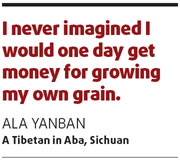Sad memories of feudal past gradually fading
Ala Yanban, 67, has the air of a man who is satisfied with life.
He earns more than 10,000 yuan ($1,400) a year from a sand factory and his two daughters also help support him. Last year, he and his wife spent nearly 30,000 yuan on traveling to Lhasa, Beijing, Chongqing and Chengdu.
"We wanted to go to Lhasa and Beijing most," he said.
Such a life would have been unimaginable when he was living under the yoke of the tusi (chieftain) of Zhuokeji town, located 9 km east of Maerkang county, capital of the Aba Tibetan-Qiang autonomous prefecture, Sichuan province.
"My life is better than when I was under the tusi'" he said.

"I could eat only dried or sour vegetables in winter, while I can get fresh vegetables every season now," he said as he stood in the building where the tusi once lived.
The tusi system lasted from the Yuan Dynasty (1271-1368) until the democratic reforms of 1956. During that period, the central government designated a local leader as tusi of different administrative areas.
The tusi were allowed to pass the title onto their sons. Their five-story building, built in the 30s, belonged to the last person to fill the post, Sonam Tselang.
The structure is near Chami village, where Ala Yanban was born. His father abandoned the family when he was little. To support itself, the family leased about 4 mu of land from a tusi to grow grain.
"In the best of years we got about 600 kg of grain. But every year we had to hand over 100 kg to the tusi, and reserve 50 kg for seeds for the coming year. As a result, we had only enough food to last a few months. The only way out was to borrow from the tusi."
The tusi, who resided in the grand building, ruled over all Tibetans living within his precinct. Common people paid rent to him and he paid tribute to the central government.
"The tusi sent his children to central areas to receive advanced education. And there were five huge moneyboxes in his treasury, each larger than a bed," Ala Yanban said.
The feudal arrangements put great pressure on Ala Yanban's family as they "handed almost everything over to the tusi - meat and even firewood."
Ala Yanban said he had to spend 10 days every month working in the tusi's building. His duties ranged from carrying water to pounding the tusi's back at night.
"But I got nothing in return, not even a meal," he said.
"Another girl experienced the same misery. She had to kneel down when she saw Sonam Tselang when her grandmother took her to see him."
Their misery started to abate in 1949. Ala Yanban saw the planes of the Communist Party of China (CPC) dropping relief materials.
After that came the land reform of 1954 and the democratic reforms of 1956. Land was distributed to peasants and Ala Yanban found he no longer had to serve the tusi. Even better, he and his neighbors were now equal to their former master.
Life has improved in the era of the reform and opening up, especially since the government cancelled the agriculture tax and started offering subsidies of 50 yuan for each mu of land.
"I never imagined I would one day get money for growing my own grain," Ala Yanban said.
And Lan Suhua, the girl he mentioned, has experienced similar changes. She was sent to the newly established Maerkang elementary school in 1952 and received a monthly subsidiary scholarship of 11 yuan as her family was poor. After graduation, she chose to go back to the farm to take care of her grandparents. In 1975, she joined the CPC.
Now Lan Suhua and her husband run a hotel called "Joy in Tibetan Family", with a yearly income of about 8,000 yuan.
"We often wonder if we had been born 30 years later, we would be enjoying life without going through those hardships," Lan Suhua said.
China Daily
(China Daily 04/23/2008 page6)














